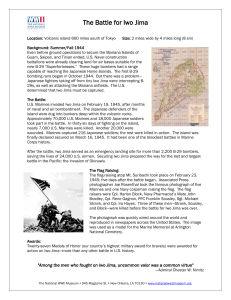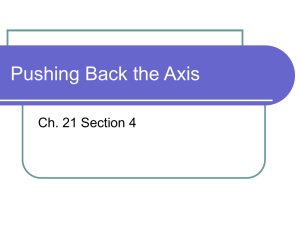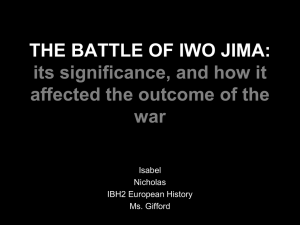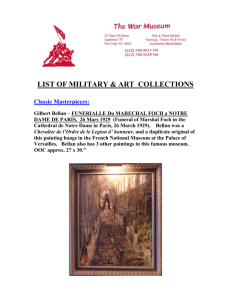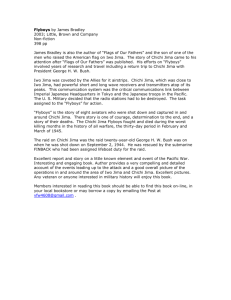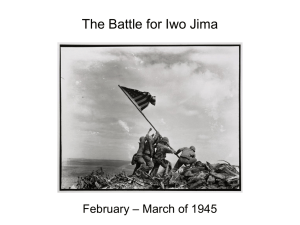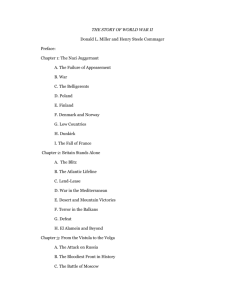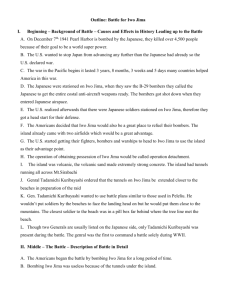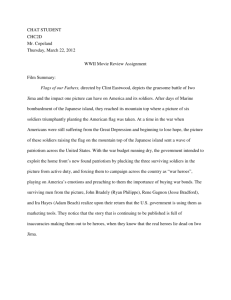Iwo Jima! Where are You? A Geography Lesson
advertisement
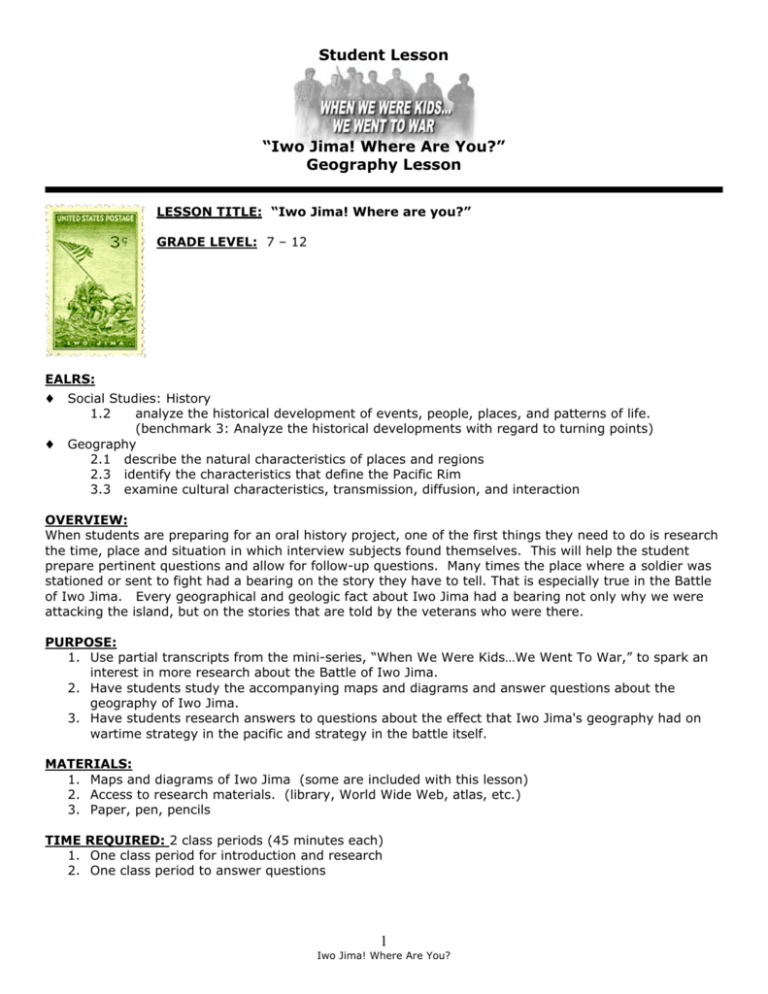
Student Lesson “Iwo Jima! Where Are You?” Geography Lesson LESSON TITLE: “Iwo Jima! Where are you?” GRADE LEVEL: 7 – 12 EALRS: ♦ ♦ Social Studies: History 1.2 analyze the historical development of events, people, places, and patterns of life. (benchmark 3: Analyze the historical developments with regard to turning points) Geography 2.1 describe the natural characteristics of places and regions 2.3 identify the characteristics that define the Pacific Rim 3.3 examine cultural characteristics, transmission, diffusion, and interaction OVERVIEW: When students are preparing for an oral history project, one of the first things they need to do is research the time, place and situation in which interview subjects found themselves. This will help the student prepare pertinent questions and allow for follow-up questions. Many times the place where a soldier was stationed or sent to fight had a bearing on the story they have to tell. That is especially true in the Battle of Iwo Jima. Every geographical and geologic fact about Iwo Jima had a bearing not only why we were attacking the island, but on the stories that are told by the veterans who were there. PURPOSE: 1. Use partial transcripts from the mini-series, “When We Were Kids…We Went To War,” to spark an interest in more research about the Battle of Iwo Jima. 2. Have students study the accompanying maps and diagrams and answer questions about the geography of Iwo Jima. 3. Have students research answers to questions about the effect that Iwo Jima's geography had on wartime strategy in the pacific and strategy in the battle itself. MATERIALS: 1. Maps and diagrams of Iwo Jima (some are included with this lesson) 2. Access to research materials. (library, World Wide Web, atlas, etc.) 3. Paper, pen, pencils TIME REQUIRED: 2 class periods (45 minutes each) 1. One class period for introduction and research 2. One class period to answer questions 1 Iwo Jima! Where Are You? ACTIVITIES AND PROCEEDURES: 1. Read the partial transcripts from the mini-series, “When We Were Kids…We Went To War. 2. Have students write down their impressions of the battle that they get from the veterans who were there. Ask if students are willing to get involved with an oral history project. 3. Hand out maps and worksheets. 4. Teachers may want students to locate landmarks on the outline map. 5. Have students answer the questions from the worksheets in complete sentences. 6. Have an oral discussion in class about the questions. EVALUATION: 1. The teacher will grade the map assignment and worksheet questions. 2. Grade student participation in the oral discussion. Iwo Jima Geography Lesson Teacher Information The Battle for Iwo Jima The island of Iwo Jima, covering only eight square miles and dominated by Mt. Suribachi, was part of the Japanese homeland. Despite the island’s small size, twenty-two thousand Japanese army and navy troops were stationed there during World War II. An intricate complex of tunnels, gun positions, and caves made the island especially formidable. As a result, before the American marines could land on February 19, 1945, Iwo Jima had to be bombed from the air for seventy-two consecutive days and bombarded from American ships for three days. Even so, it was not until four days after the marines landed that the American flag was raised on Mt. Suribachi. A photograph of the event became one of the most famous of the war. Finally, on March 26, the entire island came under American control. The battle cost the lives of 6,821 American marines and sailors and most of the Japanese fighting force. Although far from the mainland, the loss of Iwo Jima was a severe psychological blow to the Japanese. The capture of Iwo Jima was one of the most costly battles of the Pacific Theater, but it was an important victory. With Iwo Jima in American hands, Tokyo was within the range of the American fighter planes used to accompany and protect American bomber planes that were damaged or running out of fuel. 2 Iwo Jima! Where Are You? Iwo Jima Geography Lesson Selected interview Transcripts Student Handout “The first thing I saw to my left was a guy cart-wheeling about 15 feet into the air. It was either a near miss or hit by an artillery shell, or something….but he was just flying….just as I stepped off the ramp. Man, I thought…holy cripes, you know, this is not a nice place.” Don Newbold, USMC – Iwo Jima Veteran “There was a lot of Jap artillery coming at us. They hadn’t started mortars yet, but a lot of machine gun fire. We were in a little tin boat that wouldn’t stop a 50 caliber machine gun bullet.” “The biggest problem was the beach.” …. “ There are dead Marines everywhere!….floating in the water.” These were the guys who had gone in just 10 minutes before us.” “They dropped the ramp on the LCVP. He drops the ramp, and he is not in very far.” “I take the jeep off. It comes off the ramp and drops right into the water and that’s as far as it went. If you are in a vehicle, it is going to draw fire. We bailed out and got away from the jeep.” “I had gone up and dug into this soft black sand, and about 5 to 10 minutes later, a mortar shell hits right in the middle of the jeep and blows the jeep to pieces.” Tom Hartwell, USMC – Iwo Jima Veteran “The 28th turned toward (Mt.) Suribachi and the 27th regiment would turn to the north so that we could protect our flank, and so forth. And we came in and we filled in with the 27th turning to the right.” “But you look back up here like this and here is this crazy mountain. They are looking down at you. For a while, it was like shooting fish in a barrel. Don Newbold, USMC – Iwo Jima Veteran 3 Iwo Jima! Where Are You? MAPS FOR THE IWO JIMA GEOGRAPHY LESSON “IWO JIMA, WHERE ARE YOU?” TO THE TEACHER: COPY AND USE THE MAPS FOR RESEARCH AND WORKSHEET REFERENCE PACIFIC THEATER OF WAR MAP EXERCISE “IWO JIMA, WHERE ARE YOU?” On the outline map of the Pacific Theater of War, locate the following Bodies of Water Countries Cities Other 1. 2. 3. 4. 5. 6. Pacific Ocean Sea of Japan Coral Sea Indian Ocean South China Sea Philippine Sea 7. Tokyo 8. Manila 9. Honolulu 10. Seoul 11. 12. 13. 14. 15. 16. 17. Japan China French Indochina Australia Philippines New Guinea Soviet Union 4 Iwo Jima! Where Are You? 18. 19. 20. 21. 22. Iwo Jima Midway Carolina Islands Marianas Islands Hawaiian Islands Student Handout SITUATION MAP – FEBRUARY 1945 5 Iwo Jima! Where Are You? STUDENT HANDOUT Pre-war Japan 1931 6 Iwo Jima! Where Are You? STUDENT HANDOUT IWO JIMA – D-DAY – FEBRUARY 19, 1945 7 Iwo Jima! Where Are You? STUDENT WORKSHEET IWO JIMA GEOGRAPHY LESSON “IWO JIMA, WHERE ARE YOU?” Name_____________________________ Directions: Read the oral history transcripts, research information about the Battle for Iwo Jima and study the maps. Then answer the questions. 1. Where is Iwo Jima and how large is it? ______________________________________________________________________ ______________________________________________________________________ ______________________________________________________________________ _________________________________________________________________. 2. Why did the American Military want to control the island of Iwo Jima? ______________________________________________________________________ ______________________________________________________________________ ______________________________________________________________________ ________________________________________________________________. 3. Why do veterans of Iwo Jima always refer to the “soft black sand” of Iwo? ______________________________________________________________________ ______________________________________________________________________ _______________________________________________________________. 4. What significant role did geography play in the Battle for Iwo Jima? ______________________________________________________________________ ______________________________________________________________________ ______________________________________________________________________ _______________________________________________________________. 5. What is Suribachi? ______________________________________________________________________ ______________________________________________________________________ ______________________________________________________________. 6. What famous incident took place at Suribachi? ______________________________________________________________________ _____________________________________________________________. 7. Why did the marines fight to control Suribachi before taking the rest of the island? ______________________________________________________________________ ______________________________________________________________________ _____________________________________________________________. 8. How did the capture of Iwo Jima make the defeat of Japan more likely? ______________________________________________________________________ ______________________________________________________________________ ______________________________________________________________________ _______________________________________________________________. 8 Iwo Jima! Where Are You? 9. What interest did the American air force have in the battle for Iwo Jima? ______________________________________________________________________ ______________________________________________________________________ ______________________________________________________________. 10. Why did Don Newbold know as soon as he landed that “Holy cripes, you know, This is not a nice place?” ______________________________________________________________________ ______________________________________________________________________ ______________________________________________________________. 11. Why was the fall of Iwo Jima a psychological blow to Japan? ______________________________________________________________________ ______________________________________________________________________ ______________________________________________________________________ ______________________________________________________________. 12. In your research of the battle for Iwo Jima, what did you find to be the most interesting or fascinating fact or incident? ______________________________________________________________________ ______________________________________________________________________ ______________________________________________________________________ ______________________________________________________________________ ______________________________________________________________________ ______________________________________________________________________ ______________________________________________________________________ ______________________________________________________________________ __________________________________________________________________. 9 Iwo Jima! Where Are You?
